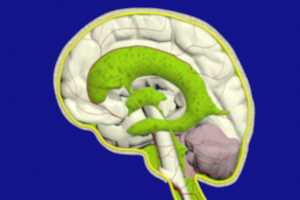Hydrocephalus due to Colloid Cyst NEU083
Hydrocephalus Colloid Cyst Transcript
Hydrocephalus due to Colloid Cyst
This is Dr. Cal Shipley with a review of colloid cysts and acute hydrocephalus.
The Ventricular System of the Brain
Let’s start by looking at the relevant anatomy of the brain. The ventricular system of the brain plays a key role in the production and circulation of cerebrospinal fluid. There are two large lateral ventricles, as well as a single third and fourth ventricle located in the midline. The ventricles of the brain are hollow chambers capable of expanding or contracting, depending on the volume and pressure of the cerebrospinal fluid within them.
Switching to a view from the left side, we can see the left lateral ventricle and the third ventricle. Each of the lateral ventricles is connected to the third ventricle by a pair of channels known as the Foramena of Monro, also known as the interventricular foramena.
The Brainstem
Looking at a cross-sectional view, the outer layer is the skull. The foramen magnum is the large opening at the base of the skull, through which the spinal cord passes.
Just above the spinal cord lying within the skull is the brainstem. The arterial system supplies a rich flow of blood to the brain.
Cerebrospinal Fluid
Cerebrospinal fluid is primarily produced in the ventricles as an ultrafiltrate of the arterial blood. (Please see my video on cerebrospinal fluid production for details on this process). The cerebrospinal fluid flows from the lateral ventricles into the third ventricle, from the third ventricle to the fourth ventricle, and then surrounds the brain and spinal cord. It then returns to the heart via the venous system.
The foramena of Monro play a critical role in facilitating flow of cerebrospinal fluid from the lateral ventricles to the third ventricle.
Hydrocephalus and Colloid Cysts
Now let’s look at how a colloid cyst can obstruct the flow of cerebrospinal fluid in the brain. A colloid cyst is a benign mucus-filled sac, which most commonly forms in the third ventricle of the brain. A colloid cyst may grow anywhere within the third ventricle, including in the area of the foramen of Monro, as shown here. Here is a view of the cyst seen in silhouette and as it appears in an MRI image of the brain.
As the colloid cyst grows, flow of cerebrospinal fluid from the lateral ventricles into the third ventricle is impaired at the foramena of Monro. As the obstruction to flow progresses, fluid pressure within the lateral ventricles increases, causing them to enlarge. Increased pressure within the ventricular system, due to a disorder in the flow of cerebrospinal fluid is known as hydrocephalus.
‘Ball Valve’ Effect
Fluid pressure from the lateral ventricles may move the position of the cyst, resulting in temporary relief of fluid obstruction, a phenomenon known as a ball valve effect. The enlargement of the lateral ventricles may also recede temporarily. This process may reoccur over the course of weeks or months with expansion and contraction of the ventricles as obstruction comes and goes with the ball valve effect.
Obstruction of the Foramena of Monro
Eventually if the cyst continues to grow, obstruction at the foramena of Monro will become complete, resulting in progressive enlargement of the lateral ventricles. The lateral ventricles in turn apply increasing pressure to the brain, compressing it against the skull. The only outlet for this pressure is at the foramen magnum at the base of the skull.
Herniation of the Brainstem
The brainstem is pushed down through the foramen magnum, a process known as herniation.
Arterial Compromise and Stroke
In this process, pressure is also applied to the arterial vasculature of the brain, causing impairment of blood flow, as contrasted in this before and after depiction. If the hydrocephalus is not relieved on an emergency basis, the impairment of blood flow will result in multiple areas of stroke throughout the brain. The term stroke refers to the death of cerebral tissue. Depicted in this example are multiple areas of stroke due to untreated acute hydrocephalus.
Cerebral Atrophy Post-Stroke
Finally, I have a series of MRI images which show, in fairly dramatic fashion, the long-term after effects of multiple concurrent strokes occurring as a result of acute hydrocephalus. In a process known as atrophy, the strokes cause the overall volume of brain to diminish. This results in a passive and permanent enlargement of the ventricles as they expand to fill the space formerly occupied by brain tissue.
Cal Shipley, M.D. copyright 2021

